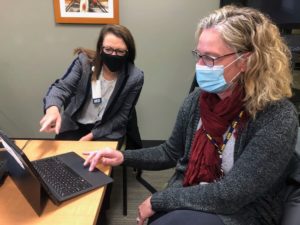
A photo on the Spokane VAMC’s Facebook page shows a Cerner Corp. physician assisting Navy Veteran Carol Good, ARNP, with VA’s new Electronic Health Record.
SPOKANE, WA — Last month, VA hit one of the largest, long-awaited milestones in the development of its new electronic health record (EHR) system—the launching of the system at its initial pilot site at the Mann-Grandstaff VAMC in Spokane, WA.
The launch had been put on hold since the end of 2019, first due to delays in training and installing the technology and infrastructure needed to run the system, then due to the COVID-19 pandemic.
The system that launches in Spokane will not be the completed her system, however. Rather it will be an incomplete version capable of supporting small and mid-sized hospitals. In the meantime, VA will continue developing the full version and add capabilities in as they are finalized.
Legislators are also concerned that the new Cerner-created system will have the same problems the Military Health System’s (MHS) Genesis system is currently experiencing when it comes to sharing information between the new system and the military’s legacy systems.
“In July DoD sent Congress a follow-up report on Genesis three years after initial go-live [noting] ongoing deficiencies in business intelligence, billing, coding, and reporting. All of which are important business of healthcare,” said Rep. Susie Lee, (D-NV) at a House Veterans’ Affairs subcommittee on technology hearing on Sept. 30. “The report also states that the information exchange with the required external systems was sporadic. And the data were frequently inaccurate or incomplete. MHS and Alta users often could not see all of the required information using the joint longitudinal viewer (JLV), creating potential patient safety concerns and eroding user trust in both the MHS Genesis and the JLV.”
Because the two systems are both Cerner-created and are meant to seamlessly share information, the original timeline was for MHS and VA to roll out the systems more-or-less simultaneously at the same sites. The initial delays at VA and now the need for VA to hold off on implementing the system at its larger hospitals has put the two rollouts on separate tracks.
Capabilities of New System
According to Bill Tinston, director of the Federal Electronic Health Record Modernization Program Office, the issues military physicians have experienced with not being able to see all the patient information in the MHS legacy systems using the JLV is an artifact of the poor records that exist in the legacy system and not the capabilities of the new system.
“Those specific [concerns in the report] were about the quality of the data in the legacy systems,” Tinston said. “I can’t make that better. I can’t make the completeness or accuracy of the information in the legacy system better than it actually is. But we do have mechanisms to bring it over [to the new system].”
Asked if the same issues will occur in the VA system, John Windom, director of VA’s Office of Electronic Health Record Modernization, did not discount the possibility. But he said VA is working to improve the JLV as well as going back into the VistA legacy system records and trying to improve the clarity of patient information before it’s transferred to the Cerner system.
“The JLV is not going away anytime soon,” he declared.
Windom also assured the subcommittee that, despite the reshuffling of VA’s rollout plan, the initial timeline and lifetime cost estimate remain the same. The rollout is expected to last until 2028 and cost an estimated $16 billion.
However, he did note that the distribution of that $16 billion will be more front-loaded than the original estimate.
“Peak spend rate seems to be much earlier than peak level of activity,” Windom explained. “This is a major IT project in addition to a major clinical and business transformation. Even shorter ones, like five years, there are substantial efficiencies gained in IT, whether they be cloud computing or software as a service. Things that inherently create efficiencies in cost savings. We anticipate substantial efficiencies toward the tail end of the contract.”
The larger up-front costs are the result of VA needing to build new infrastructure like data centers and data hosting facilities, as well as thing like developing new user training packages.
While the EHRS rollout looks to move forward, VA has put the rollout of its new Cerner scheduling system on hold. The department had initially decoupled the scheduling system from the larger EHR system with the hopes that it could roll it out more quickly than the full system. The new scheduling system launched at the Columbus VA Medical Center in August.
VA has now decided to put the CSS on hold indefinitely.
“The Cerner scheduling system is not off the table,” Windom told legislators. “In this COVID environment we had to look at numerous parameters, including manpower and social distancing. … We thought the Cerner scheduling decision could wait.”
The next hospital slated to have the new EHRS installed is the Walla Walla VAMC, along with other facilities in VISN 20. VA will then move on to VISN 10 in Ohio, Indiana and Michigan.

